Exercises (3161)
Self-massage: forearm muscles
Relaxation
Individual work
Starting position:
Lying on the floor, stretch out your arm and pinch the ball between your forearm and the floor (palm facing upwards).
Execution:
Grab the forearm with your free arm and press lightly against the floor to increase the intensity. Slowly move the ball along the forearm. If a point on the forearm is particularly painful, you can press the ball onto this point for several seconds to help release tension. Then switch sides.
1 massage ball
Self-massage: calf muscles/ Achilles tendon
Relaxation
Individual work
Starting position:
Sitting position, place your arms next to (or behind) your buttocks. Place the ball under the calf muscle and bend the other leg slightly.
Execution:
Lift the buttocks slightly and guide the ball along the calf muscle by bending and stretching the bent leg. Rotate the foot to ensure that the entire calf muscle is covered. If one point in the calf muscles is particularly painful, the ball can be pressed onto this point for several seconds to relieve tension. Then switch sides.
1 massage ball
Independent preparation
Transition main part
Each participant uses the time provided to prepare specifically for the following sporting requirements according to their own needs (e.g. additional mobilisation/dynamic stretching exercises, short forms of strengthening or sprints).
Independent preparation/practice
Miscellaneous
Each participant uses the time provided to prepare specifically for the following sporting requirements according to their own needs. This may involve exercises that affect the participant's own body (mobilisation exercises, dynamic stretching, increasing heart rate, strengthening) or it may also be possible to practise on a piece of equipment/aid in order to prepare for a possible task/exam.
Lowering the shoulders on a slope (active slope) ► active hang
Power
Individual work

Hold on to the horizontal bar in a hanging position (full body extension, arms stretched out overhead in a high position - passive hang) (the position can be assumed with the help of a bench or a chair), the hands grasp the bar with an overhand grip (palms facing backwards), the arms are positioned shoulder-width apart. Switch from the passive to the active hang by pulling the shoulders downwards while the elbows remain stable. Hold the position for as long as possible. After the exercise, slowly place your feet back on the chair or bench before releasing your hands from the bar or dropping to the floor to stand.
Attention:
Let your upper body hang still (no swinging; tense your core muscles); arms are fully extended (no bending of the elbows); do not deliberately point your chest upwards, but try to work only in the vertical plane by pulling your shoulders downwards.
Lighten:
Do the exercise for a shorter period of time; use the elastic band as support (place one or both feet on the band).
Harden:
Additional weight.
Variant I:
Knee bent.
Variant II:
Grab the bar with a neutral grip or underhand grip (palm facing your face).
1 horizontal bar
1 elasticated rubber band ► Make the exercise easier (support)
2 weight cuffs/1 weight waistcoat ► Make the exercise more difficult (additional weight)
Lowering the upper body in the seat
Power
Individual work


Sit upright on the Swedish box (or a long bench) with your arms folded across your chest. Lean your upper body backwards and hold the position.
Attention:
Straight back.
Lighten:
Lean your upper body less far backwards; keep your arms in front of you.
Harden:
Place your arms at an angle next to your head or even hold them up; keep additional weight on your chest.
Variant:
Change the distance between your feet and your buttocks.
2-3 vaulting box elements (incl. top section) or 1 long bench
1 weight vest/weight disc/dumbbell/sandbag ► Make the exercise more difficult (additional weight)
Lowering and raising the arms while standing
Power
Individual work


When standing, hold the bar with your hands shoulder-width apart. Keeping your arms almost outstretched, bring them down towards your thighs and back to the starting position.
Starting position:
- Stand shoulder-width apart, knees (slightly) bent
- Leg and gluteal muscles tensed
- Arms held almost straight up, hands grasping the bar with an overhand grip
Finishing position:
- Bar (almost) touching your thighs
- Arms still almost straight
Attention:
Keep your back straight throughout the exercise. The movement only comes from the shoulders, not the upper body
1 weight tower/machine ► Cable pulley (high)
Lowering and raising the arms in supine position
Power
Individual work
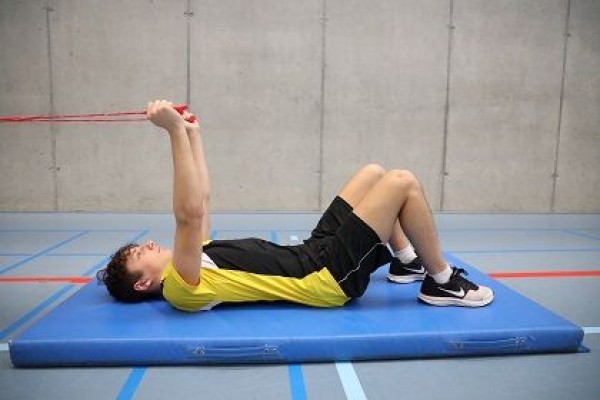
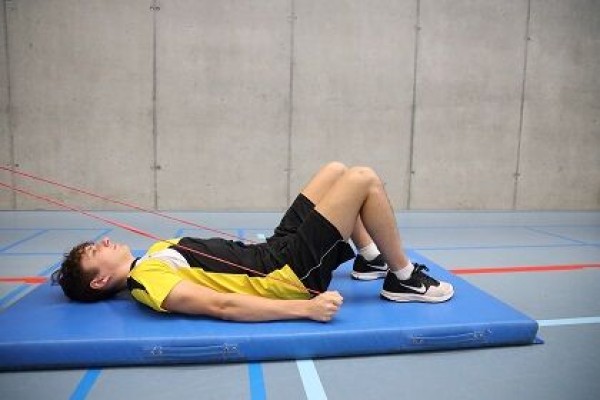
Lie on your back (head on the wall bars/tree) with your legs up and arms stretched vertically upwards. Attach the elastic band to the wall bars/tree at hand height and grasp the elastic band with your hands. Stretch your arms towards your knees and back to the starting position, with the movement only taking place in the shoulder joint.
Attention:
The upper body always remains flat on the floor.
Lighten:
Select a rubber band with less resistance.
Harden:
Select a rubber band with greater resistance.
Variation:
Pass both arms alternately left and right past the knees.
1 elasticated rubber band
1 wall bar/tree
Lowering and raising the arms in supine position
Power
Individual work


While lying on your back on the flat bench, hold the dumbbells in a neutral grip with your arms almost straight above your collarbone. With your elbows slightly bent, move the weights evenly outwards and downwards in an arc. When the dumbbells are at head height, pause briefly before pushing the weights up again.
Starting position:
- Lie on your back on the flat bench
- Arms (almost) stretched out in a high position, grasp dumbbells in a neutral grip
- Avoid a hollow back position (tense your torso)
- Legs are either bent in a high position or placed on the floor or flat bench
- The dumbbells are held in a neutral position.
Final position:
- Dumbbells are lowered in a parallel arc to head height (arms practically form a line)
Variant:
The exercise can also be performed on an incline bench. The bench should be set at an angle of around 45 degrees. The movement idea remains the same.
1 flat bench
2 dumbbells
Lowering and raising the legs in supine position ► leg raise
Power
Partner work
1 trainee & 1 helper ► Note change of position
(= double the time required; for lesson planner see Organisation Kraft: Info button Execution)


Trainee: Hold the legs of the standing partner in a supine position. Extend the legs vertically upwards and when the partner wants to push the legs towards the floor, hold against them/brake the downward movement so that the legs never touch the floor.
Partner: Hold the trainee's legs in a high position and push them towards the floor.
Attention:
Always listen to/respond to your partner (adjust pressure/intensity). Keep your back in constant contact with the floor (no hollow back, consciously tense your stomach), do not put your legs down, keep your legs as straight as possible.
Lighten:
Just hold the position (legs stretched out in extension of the upper body), raise and lower your legs without additional impulse from your partner.
Harden:
Increased impulse from the partner; additional weight for the legs.
Variant:
The partner pushes the legs not only straight towards the floor but also to the side (direction known to the exerciser or arbitrarily defined by the partner).
2 weight cuffs/ 1 (weighted) ball ► Make the exercise more difficult
Lowering and raising the upper body while kneeling
Power
Individual work
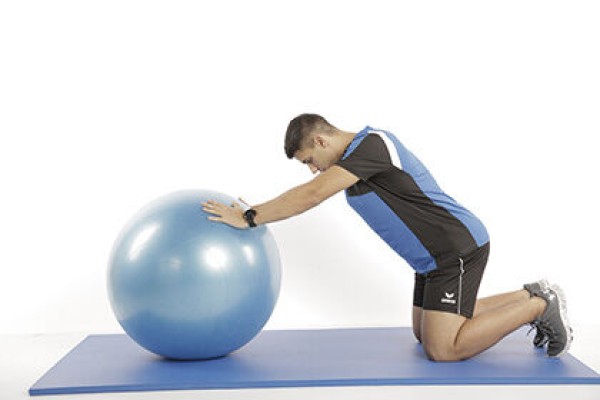

Kneeling (buttocks not resting on your heels, right angle at the knees), support your upper body with your hands on the exercise ball. Roll the exercise ball forwards and back to the starting position and move your upper body with it.
Attention:
Do not fall into a hollow back (actively tense your torso).
Lighten:
Roll the ball less forwards.
Harden:
Lift your knees.
1 exercise ball
Lowering and raising the upper body while kneeling
Power
Partner work
1 trainee & 1 helper ► Note change of position
(= double the time required; for lesson planner see Organisation Kraft: Info button Execution)

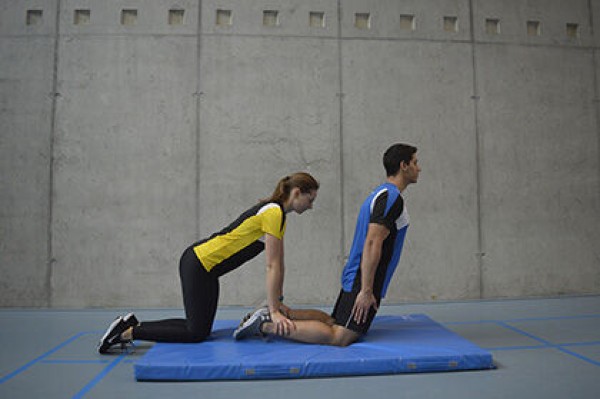
Exerciser: Kneeling with the upper body upright (approx. 90 degrees at the knee joint, no sitting on the heels) and arms folded across the chest. Tilt your upper body forwards as far as possible and straighten up again (movement in the knee joint).
Partner: Hold the legs of the active participant.
Attention:
Straight back.
Lighten:
Just hold the position (the more upright the position, the easier); arms point backwards to the side of the body.
Harden:
Place your arms at an angle next to your head or hold them up; hold additional weight (on your chest).
Variant:
Slowly tilt your upper body forwards as far as possible until you support any fall with your hands.
1 weight disc ► Make the exercise more difficult (additional weight)
Lowering and raising the upper body while kneeling ► Abdominal crunch
Power
Individual work


Stand on your knees with your upper body slightly bent forward in front of the high cable pulley (both positions are possible: facing towards or away from the cable pulley). Build up strength in your core and curl your upper body in a controlled manner. When raising the upper body, work slowly and in a controlled manner until the back is stretched out again.
Starting position:
- Kneel, upper body slightly bent forward
- Hold the cable pulley at head height with both hands and bent arms
Finishing position:
- Pull your elbows and head towards your knees
- Roll up your upper body
Attention:
Do not work with momentum. Only work with as much weight as you can control. It is best to train the technique without weight first. Keep your core tensed the whole time and don't fall into a hollow back.
1 weight tower/machine ► Cable pulley (high)
Lowering and raising the upper body while kneeling ► ghd glute ham raise
Power
Individual work



In a kneeling position on the back of the padding with the upper body upright, fix the feet in the holder (feet pointing downwards), hold the arms on the chest or cross them, tense the abdominal muscles, do not overstretch the spine (straight back). Lower your upper body until it is parallel to the floor (horizontal). To lower, push your knees behind the pad. Depending on the training level, the upper body can also be lowered less far or even lower. Once you have reached the end position (with legs straight), bend your legs and tense your gluteal muscles to return to the starting position on your knees.
Attention:
Keep your back straight (tense your core).
Lighten:
Lower your upper body less (not all the way to horizontal); training partner for support.
Harden:
Lower your upper body beyond horizontal; additional weight (on your chest).
1 glute-ham developer (GHD)
1 weight disc ► to make the exercise more difficult (additional weight)
Lowering and raising the upper body in the seat
Power
Individual work


Sit upright on the Swedish box (or a long bench) with your arms folded across your chest. Lower your upper body backwards and straighten up (do not fully return to the starting position).
Attention:
Straight back, constant tension in the abdominal muscles, head in a neutral position (no double chin).
Lighten:
Lean your upper body less far back; keep your arms forward.
Harden:
Place your arms at an angle next to your head or even hold them up; keep additional weight on your chest.
Variant:
Change the distance between your feet and buttocks.
2-3 vaulting box elements (incl. top section) or 1 long bench
1 weight vest/weight disc/dumbbell/sandbag ► Make the exercise more difficult (additional weight)
Lowering and raising the upper body in the seat
Power
Individual work


Sit on the Swedish box (or a long bench) with your arms folded across your chest. Bend your upper body forwards and return to the starting position.
Attention:
Start stretching consciously in the lower back and try to stretch vertebra by vertebra, rolling back in from the head.
Lighten:
Support your arms on the top of the swinging box.
Harden:
Bend your arms next to your head (hands on your neck) or hold them up; keep additional weight on your chest.
2-3 vaulting box elements (incl. top section) or 1 long bench
1 weight disc/dumbbell/sandbag ► Make the exercise more difficult (additional weight)
Lowering and raising the upper body while seated ► Abdominal crunch
Power
Individual work
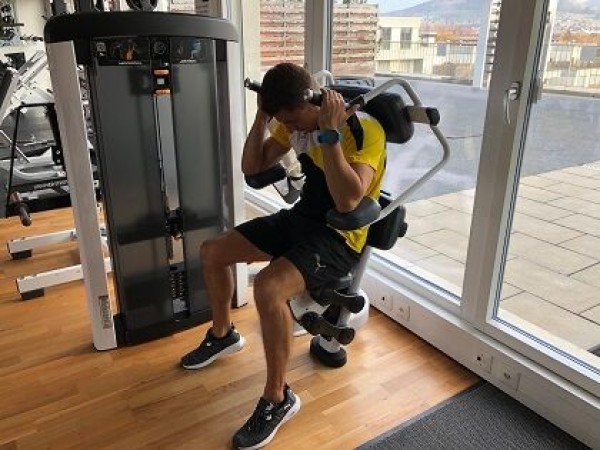

Grab the handles behind your head and position your elbows on the cushions, tense your core muscles and pull your upper body down towards your legs, then raise your upper body back up to the starting position.
Starting position:
- Sitting with the upper body slightly overstretched
- Grasp the handles with your hands behind your head
- Rest your elbows on the cushion
Finishing position:
- Grip unchanged
- Bring your upper body closer to your legs
Attention:
Work from the core muscles, which means that you should not pull with your hands or push with your elbows.
Lowering and raising the upper body in the seat ► back extension / lower back
Power
Individual work


Place the shoulder blades on the cushion, push the upper body backwards from the forward-leaning position against the resistance while sitting, using the thigh and buttock muscles to support the lower back.
Starting position:
- Sitting with the upper body leaning forwards
- Straight back stretched out
Finishing position:
- Upright posture or upper body leaning backwards
- Position of the back unchanged
Lowering and raising the upper body while standing
Power
Individual work


Stand upright, shoulder-width apart with your feet in the loops. Hold the gymnastics pole with outstretched arms in an overhand grip slightly wider than hip-width in front of your body (back of hands pointing forwards), tilt your upper body forwards with a straight back and bend your knees slightly. Stretch your legs and straighten your upper body again to return to the starting position.
Attention:
The movement takes place in the hip joint, move the gymnastics bar close to your body, keep your back straight.
Lighten:
Choose less strong elastic bands; roll up the elastic bands less.
Harden:
Choose stronger elastic bands; roll up the elastic bands more.
Variation:
Hold the gymnastics bar on your shoulders behind your head (longer lever).
1 gymnastic bar with elasticated straps
Lowering and raising the upper body while standing
Power
Individual work


Stand with your feet shoulder-width apart and hold the gymnastics pole on your shoulders behind your head. Your feet are in the loops, your knees are slightly bent and your upper body is leaning forwards with a straight back. Bend your upper body and roll back up to the starting position.
Attention:
The pelvis remains stable and should not move, so try to straighten your upper body vertebra by vertebra.
Lighten:
Choose less strong elastic bands; roll up the elastic bands less.
Harden:
Choose stronger elastic bands; roll up the elastic bands more.
Variation:
Hold the gymnastics bar at knee height with outstretched arms instead of on your shoulders.
1 gymnastic bar with elasticated straps
Lowering and raising the upper body while standing
Power
Individual work


Stand upright, shoulder-width apart, hold a dumbbell/kettlebell in each hand in front of your body at hip height (backs of hands pointing forwards), tilt your upper body forwards with a straight back and move the weight towards your shins. Lower the weight as far as you can keep your back straight before raising your upper body back to the starting position.
Attention:
The movement takes place in the hip joint, move the weight close to the body, keep your back straight.
Lighten:
Less weight or no weight at all.
Harden:
More weight.
2 dumbbells/kettlebells
Lowering and raising the upper body while standing (left) ► windmill
Power
Individual work


Stand upright with the weight (dumbbell or kettlebell) with one arm (left) stretched out overhead (arm almost stretched out in an upright position), bend the leg (right - opposite side of the hand with the weight) and push the buttocks backwards without losing stability in the back, always looking towards the weight and finally lowering the upper body down/leaning forwards at an angle. The free arm (right) is brought crosswise to the shin of the extended leg (left). Then work the weight out of the torso in a controlled manner and push it back up to the upright starting position.
Starting position:
- Stand upright, shoulder-width apart
- Stabilise the weight with one arm overhead in a high position
- Tense the abdominal and gluteal muscles
- Look forwards
Finishing position:
- One leg extended, the other slightly bent (opposite side of the hand with the weight)
- Buttocks pushed backwards
- Upper body lowered/inclined forwards, free arm touches the shin crosswise
- Back remains straight
- Gaze directed towards the weight
Attention:
This exercise places high demands on mobility and stability, which is why it is only suitable for experienced exercisers.
1 dumbbell/kettlebell
Lowering and raising the upper body while standing (right) ► windmill
Power
Individual work

Stand upright with the weight (dumbbell or kettlebell) with one arm (right) stretched out overhead (arm almost stretched out in an upright position), bend the leg (left - opposite side of the hand with the weight) and push the buttocks backwards without losing stability in the back, always looking towards the weight and finally lowering the upper body down/leaning forwards at an angle. The free arm (left) is brought crosswise to the shin of the extended leg (right). Then work the weight out of the torso in a controlled manner and push it back up to the upright starting position.
Starting position:
- Stand upright, shoulder-width apart
- Stabilise the weight with one arm overhead in an upright position
- Tense the abdominal and gluteal muscles
- Look forward
Finishing position:
- One leg extended, the other slightly bent (opposite side of the hand with the weight)
- Buttocks pushed backwards
- Upper body lowered/inclined forwards, free arm touches the shin crosswise
- Back remains straight
- Gaze directed towards the weight
Attention:
This exercise places high demands on mobility and stability, which is why it is only suitable for experienced exercisers.
1 dumbbell/kettlebell
Lowering and raising the upper body while standing ► romanian deadlift
Power
Individual work


Start standing, bend your upper body so that the barrel of the rifle is pointing towards the ground and return to the starting position.
Lighten:
Bend/lower your upper body less.
1 assault rifle (neutralised)
Lowering and raising the upper body in prone position (hip and back extension) ► ghd hip and back extension
Power
Individual work
Place the thighs on the padding and fix the feet in the holder (feet pointing downwards). Make sure that the support pad is adjusted so that the hips are free and the legs are straight. The hips are extended, the exposed upper body is kept horizontal and the arms are held on the chest or crossed. From this position, lower the upper body, first lowering/tilting the chin towards the chest before starting to bend the spine in the neck. The upper back is then rolled up, followed by the lower back. Finally, the hips are flexed and the spine is briefly stretched. Once in the end position, the hips are stretched first in reverse order, while the spine is flexed. The hips remain stretched as the lower back and then the upper back are stretched. With a neutral spine and stretched hips, return to the starting position (upper body horizontal to the floor).
Caution:
Consciously curl or uncurl your back vertebra by vertebra.
Lighten:
-
Lighten:
Additional weight (on the chest)
1 glute-ham developer (GHD)
1 weight disc ►to make the exercise more difficult (additional weight)